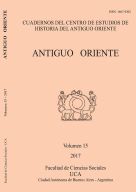Por favor, use este identificador para citar o enlazar este ítem:
https://repositorio.uca.edu.ar/handle/123456789/7248| Campo DC | Valor | Lengua/Idioma |
|---|---|---|
| dc.contributor.author | James, Peter | es |
| dc.date.accessioned | 2019-06-20T00:03:34Z | - |
| dc.date.available | 2019-06-20T00:03:34Z | - |
| dc.date.issued | 2017 | - |
| dc.identifier.citation | James, P. The levantine war-records of Ramesses III : changing attitudes, past, present and future [en línea]. Antiguo Oriente. Cuadernos del Centro de Estudios de Historia del Antiguo Oriente. 2017, 15 Disponible en: https://repositorio.uca.edu.ar/handle/123456789/7248 | es |
| dc.identifier.issn | 1667-9202 | - |
| dc.identifier.uri | https://repositorio.uca.edu.ar/handle/123456789/7248 | - |
| dc.description.abstract | Abstract: This paper begins with a historiographic survey of the treatment of Ramesses III’s claimed war campaigns in the Levant. Inevitably this involves questions regarding the so-called “Sea Peoples.”1 There have been extraordinary fluctuations in attitudes towards Ramesses III’s war records over the last century or more—briefly reviewed and assessed here. His lists of Levantine toponyms also pose considerable problems of interpretation. A more systematic approach to their analysis is offered, concentrating on the “Great Asiatic List” from the Medinet Habu temple and its parallels with a list from Ramesses II. A middle way between “minimalist” and “maximalist” views of the extent of Ramesses III’s campaigns is explored. This results in some new identifications which throw light not only on the geography of Ramesses III’s campaigns but also his date. | es |
| dc.description.abstract | Resumen: Este artículo comienza con un recorrido historiográfico del tratamiento de las supuestas campañas bélicas de Ramsés III en el Levante. Inevitablemente esto implica preguntarse sobre los llamados “Pueblos del mar”. Ha habido cambios extraordinarios en las actitudes en torno a los registros de guerra de Ramsés III a lo largo del último siglo y antes—aquí brevemente reseñadas y reevaluadas. Sus listas de topónimos levantinos también presentan problemas de interpretación. Ofrecemos un acercamiento a su análisis, más sistemático, concentrándonos en la “Gran lista asiática” del templo de Medinet Habu y sus paralelos con la lista de Ramsés II. Exploramos una interpretación intermedia entre las visiones “minimalista” y “maximalista” de la extensión de la campaña de Ramsés III. Esto nos lleva a algunas nuevas identificaciones que iluminan no solamente la geografía de la campaña de Ramsés III sino también su datación. | es |
| dc.format | application/pdf | es |
| dc.language.iso | eng | es |
| dc.publisher | Pontificia Universidad Católica Argentina. Facultad de Ciencias Sociales. Departamento de Historia. Centro de Estudios de Historia del Antiguo Oriente | es |
| dc.rights | Acceso Abierto | es |
| dc.rights.uri | https://creativecommons.org/licenses/by-nc-sa/4.0/ | es |
| dc.source | Antiguo Oriente. Cuadernos del Centro de Estudios de Historia del Antiguo Oriente. 2017, 15 | es |
| dc.subject | HISTORIA DE EGIPTO | es |
| dc.subject | HISTORIOGRAFIA | es |
| dc.subject | HISTORIA MILITAR | es |
| dc.subject | TOPONIMIA | es |
| dc.subject | ARQUEOLOGIA | es |
| dc.title | The levantine war-records of Ramesses III : changing attitudes, past, present and future | es |
| dc.title | Los registros de la guerra levantina de Ramsés III : actitudes cambiantes, pasado, presente y futuro | es |
| dc.type | Artículo | es |
| uca.path | Antiguo Oriente: Cuadernos del Centro de Estudios de Historia del Antiguo Oriente|2017 vol. 15 | es |
| uca.disciplina | HISTORIA | es |
| uca.filename | /home/data-uca-generic/folder_revistas/Revistas varias/antiguooriente/Antiguo oriente15/the-levantine-war-records/metadata.xml | es |
| uca.issnrd | 1 | es |
| uca.affiliation | Fil: James, Peter. Investigador independiente; Reino Unido | es |
| uca.orden | 04 | es |
| uca.version | publishedVersion | es |
| item.languageiso639-1 | en | - |
| item.fulltext | With Fulltext | - |
| item.grantfulltext | open | - |
| Aparece en las colecciones: | AO - 2017 vol. 15 | |
Ficheros en este ítem:
| Fichero | Descripción | Tamaño | Formato | |
|---|---|---|---|---|
| the-levantine-war-records.pdf | 2,69 MB | Adobe PDF |  Visualizar/Abrir |
Visualizaciones de página(s)
220
comprobado en 30-abr-2024
Descarga(s)
3.497
comprobado en 30-abr-2024
Google ScholarTM
Ver en Google Scholar
Este ítem está sujeto a una Licencia Creative Commons

